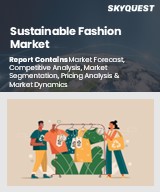
Report ID: SQMIG25M2083
SkyQuest Technology's Sustainable fashion market size, share and forecast Report is based on the analysis of market data and Industry trends impacting the global Sustainable Fashion Market and the revenue of top companies operating in it. Market Size Data and Statistics are based on the comprehensive research by our Team of Analysts and Industry experts.
Global Sustainable Fashion Market size was valued at USD 7.9 billion in 2023 and is poised to grow from USD 9.65 billion in 2024 to USD 47.65 billion by 2032, growing at a CAGR of 22.1% during the forecast period (2025-2032).
Growing awareness regarding sustainability, advancements in textile technologies, rise of ethical consumerism, and imposition of stringent regulations on textile companies are helping promote the sales of sustainable fashion products.
Rising global concern about climate change, pollution, and the environmental impact of fast fashion is pushing consumers toward sustainable fashion. Governments worldwide are implementing stricter regulations on textile production, waste disposal, and carbon emissions, supporting the sustainable fashion sector. Launch of innovative new sustainable textile technologies and rise of ethical consumerism are also favoring the global sustainable fashion market growth. Investors and fashion brands are increasingly backing sustainability as a core strategy to amplify their reach and stand out from the competition.
On the contrary, high costs of sustainable materials, greenwashing by brands, misinformation regarding sustainable fashion, and supply chain complexity are anticipated to impede the global sustainable fashion market penetration across the study period.
How Can Technology Power the Sustainable Fashion Revolution?
Technology is revolutionizing transparency in the fashion supply chain. Blockchain, QR codes, and AI-powered platforms are helping brands provide end-to-end visibility—from raw materials to finished products. Consumers can now scan labels to verify ethical sourcing, labor practices, and carbon footprints. This level of traceability builds trust and combats the issue of greenwashing. Brands like Everlane and Stella McCartney lead in showcasing transparent operations. Regulatory pressure and consumer demand for authenticity further accelerate adoption of digital technologies. As digital tools improve supply chain data collection and verification, traceability is not just a feature but a competitive advantage, shaping the next phase of sustainable fashion innovation.
REQUEST FOR SAMPLE
Global Sustainable Fashion Market size was valued at USD 7.1 Billion in 2023 and is poised to grow from USD 7.72 Billion in 2024 to USD 15.04 Billion by 2032, growing at a CAGR of 8.7% during the forecast period (2025-2032).
Sustainable fashion providers should focus on raising awareness regarding sustainability to maximize business scope. Launch of innovative marketing campaigns and collaborations with leading sustainable fashion designers can also help boost sales potential. Investing in Europe is expected to offer highly lucrative returns for all companies as per this global sustainable fashion market analysis. 'Allbirds', 'Mud Jeans', 'ArmedAngels', 'Amour Vert', 'Eileen Fisher Inc', 'Everlane', 'Mara Hoffman', 'Veja', 'Patagonia Inc', 'wunderwerk', 'Reformation', 'Macy's'
Modern consumers are increasingly aligning their purchases with personal values. Ethical consumerism, which includes fair trade practices, labor rights, and cruelty-free production, is fueling the demand for sustainable fashion. Shoppers are now interested in how their clothes are made, who makes them, and under what conditions. Transparency and traceability in the supply chain have become major selling points. All of these factors are slated to drive up the sales of sustainable fashion products.
Adoption of Circular Fashion Models: Circular fashion is becoming a dominant trend as brands shift from linear production to closed-loop systems. This involves recycling old garments into new ones, offering take-back programs, and launching repair or resale services. Consumers increasingly favor brands that reduce waste and extend the lifecycle of clothing. As sustainability becomes a core value, circular fashion is projected to emerge as an indispensable sustainable fashion market trend.
How Will Demand for Sustainable Fashions Fare in the European Region?
Want to customize this report? This report can be personalized according to your needs. Our analysts and industry experts will work directly with you to understand your requirements and provide you with customized data in a short amount of time. We offer $1000 worth of FREE customization at the time of purchase.
Feedback From Our Clients

Report ID: SQMIG25M2083
sales@skyquestt.com
USA +1 351-333-4748